Kawashima Selkon Textiles (transportation interior material business)
| 1843 | 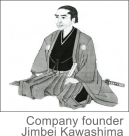 Company founder Jimbei Kawashima opened a modest but comprehensive fabrics store (shop name:Uedaya) Company founder Jimbei Kawashima opened a modest but comprehensive fabrics store (shop name:Uedaya) |
|---|---|
| 1886 | 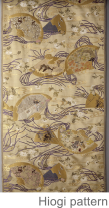 The company presented a figured fabric “Hiogi pattern” to the German Imperial Household. The company presented a figured fabric “Hiogi pattern” to the German Imperial Household. |
| 1888 | The company produced interior decoration fabrics for the Meiji Palace and became the first company in Japan to launch an interior decoration and curtain business. |
| 1891 | The company became the first Japanese purveyor to the Imperial Household Agency. |
| 1893 | 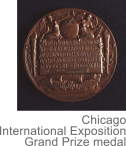 The company registered a patent for ‘Chiyokanoko Asahiori’, which became the first patent granted for fabric in Japan. The company registered a patent for ‘Chiyokanoko Asahiori’, which became the first patent granted for fabric in Japan.The company exhibited a hand-woven brocade tapestry in the Chicago International Exposition in the U.S.A. and was awarded the grand prize. The company’s decorative fabric was incorporated into the interior design of Japan National Railway’s No.7 train compartment for the use of the Emperor and the Empress. |
| 1938 | The company was reorganized as a corporation to establish Kawashima Jimbei Store Co., Ltd. |
| 1946 | The company received moquette fabric orders for vehicle seats of the Occupation Forces from the Department of Transportation. |
| 1953 | The company started to develop seat fabric for the 1st Toyota Crown model. (First featured in Crown in 1957) |
| 1956 | The company’s flat woven fabric was featured on Nissan Austin seat. (The first in Japan) |
| 1957 | The company changed its name to Kawashima Textile Manufacturers Ltd. |
| 1960 | The company’s seat fabric was featured in Japan Airlines YS-11 aircrafts. |
| 1964 | The company’s curtain material was featured in Japan National Railway Shinkansen (bullet train) cars. |
| 1965 | The company’s tricot knit fabric was incorporated into the interior design of automobiles. (The first in Japan) |
| 1969 | The company produced automobile interior fabric for Toyota Century for the Imperial Household Agency. |
| 1972 | The company’s automobile moquette fabric was featured in Mazda Luce. (The first in the world) |
| 1976 | The company’s automobile jacquard moquette fabric was featured in Toyota Crown. (The first in the world) |
| 1979 | The company started to supply carpets to Japan Airlines. |
| 1981 | The company’s clipped velour tricot knit fabric was incorporated into automotive interior. (The first in the world) |
| 1982 | The company’s automobile double raschel fabric (with the same pattern on both sides) was featured in Honda Prelude for the first time. |
| 1984 | 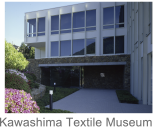 The company opened Textile Museum in Ichihara, Kyoto. The company opened Textile Museum in Ichihara, Kyoto. |
| 1985 | The company’s automobile wool moquette fabric was featured in Honda Legend. (The first in Japan) |
| 1987 | The company’s antistatic seat fabric was featured in automobiles. (The first in Japan) |
| 1990 | The company produced interior decoration fabrics for large luxury liners, Nippon-maru and Chrystal Harmony. |
| 1997 | Automotive division of the company obtained ISO 9001 certification. The company’s suede tricot fabric was incorporated into automotive interior. (The first in the world) |
| 1998 | Automotive division of the company obtained QS-9000 certification. |
| 2001 | Shiga plant & office of the company obtained ISO 14001 certification. |
| 2002 | The company established Kawashima Textile Manufacturers (Shanghai) Ltd. in China and Kawashima Textile USA, Inc. (current TB Kawashima USA, Inc.) in USA. |
| 2004 | Automotive division of the company acquired ISO/TS 16949 certification. The company established Shanghai Kawashima Shenda Dyeing & Finishing Co., Ltd. in China. The company exhibited at Tokyo Motor Show for the first time. |
| 2006 | The company and Selkon Co., Ltd. merged to form Kawashima Selkon Textiles Co., Ltd. The company established PT. Ateja Kawashima Autotex in Indonesia. |
| 2007 | The company’s seat fabric, curtain, and carpet were featured in JR Shinkansen N700 series. The company produced interior fabric for the Heisei train compartment for the Imperial Family. The company acquired 100% ownership of Seiwa Co., Ltd. |
| 2008 | The company’s banex® material was featured in the Skyliner trains of Keisei Electric Railway. The company acquired 100% ownership of Kawashima Selkon (Thailand) Co., Ltd. (current TB Kawashima (Thailand) Co., Ltd. in Thailand. |
Toyota Boshoku Corporation (transportation interior materials business)
| 1918 | 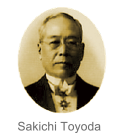 Toyoda Boshoku Corporation (the forerunner of Toyota Boshoku) was founded by Sakichi Toyoda, a power loom inventor. Toyoda Boshoku Corporation (the forerunner of Toyota Boshoku) was founded by Sakichi Toyoda, a power loom inventor. |
|---|---|
| 1921 | 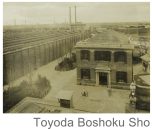 Sakichi Toyoda established Toyoda Boshoku Sho in Shanghai, China. Sakichi Toyoda established Toyoda Boshoku Sho in Shanghai, China. |
| 1942 | The company changed its name to Chuo Spinning Company. (Merged with Chuo Boshoku, Toyoda Oshikiri Boshoku, Utsumi Boshoku, and Kyowa Boseki) |
| 1943 | Chuo Spinning Company merged with Toyota Motor Co., Ltd. (currently Toyota Motor Corporation)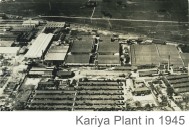 |
| 1947 | Arakawa Sheet Metal Industries Co., Ltd. was established. |
| 1950 | Minsei Spinning Co., Ltd. was established as a separate entity from Toyota Motor Co., Ltd. (currently Toyota Motor Corporation) |
| 1954 | The company started to produce seats for Toyopet Crown RS model. |
| 1960 | Takashimaya Nippatsu Industries Co., Ltd. was jointly established by Toyota, Takashimaya, Takashimaya Kosakujo, and Nippon Hatsujo. |
| 1961 | Arakawa Sheet Metal Industries changed its corporate name to Arakawa Auto Body Co., Ltd. |
| 1967 | 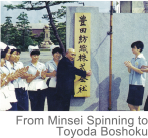 The company changed its name to Toyota Boshoku Corporation. The company changed its name to Toyota Boshoku Corporation. |
| 1970 | The company started to produce raw yarn for automobile carpet at Oguchi South Plant. |
| 1972 | 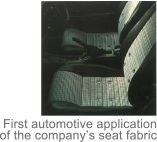 The company commenced development for automobile seat fabric. (First featured in 1973) The company commenced development for automobile seat fabric. (First featured in 1973)The company started production of automobile seat fabric at Oguchi South Plant. |
| 1988 | Arakawa Auto Body changed its corporate name to Araco Corporation. |
| 2000 | The company merged with Toyota Kakoh Co., Ltd. |
| 2003 | Takashimaya Nippatsu Industries changed its corporate name to Takanichi Co., Ltd. |
| 2004 | Toyoda Boshoku, Araco, and Takanichi merged and the company name changed to Toyota Boshoku Corporation. |
Toyoda Boshoku: Black text / Araco: Blue text / Takanichi: Green text
Tatsumura Textile AI
| 1894 | 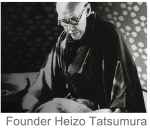 Heizo Tatsumura I founded textile business. Heizo Tatsumura I founded textile business. |
|---|---|
| 1923 | The company produced fabrics for the book cover of the international travelogue written by the Crown Prince. |
| 1957 | The company supplied seat covers to Japan Airlines. |
| 1961 | 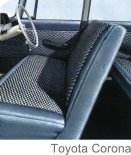 The company started seat fabric business. The company started seat fabric business. |
| 1963 | The company’s jacquard flat woven fabric was featured in automobiles. |
| 1964 | The company’s woven fabric made of nylon textured yarn was featured in automobiles. (The first in the industry) |
| 1969 | The company’s piece dyed fabric was featured in automobiles. (The first in the industry) |
| 1987 | 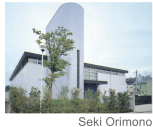 The company established a jacquard moquette factory, Seki Orimono Co., Ltd. in Seki, Gifu. The company established a jacquard moquette factory, Seki Orimono Co., Ltd. in Seki, Gifu. |
| 2001 | Tatsumura Textile AI, Co., Ltd. was established by Toyota Tsusho Corporation, Teijin Tecloth Co., Ltd., and Tatsumura Texcile Co., Ltd., to spin off Tatsumura Texitile’s automotive fabric division into an independent business entity. |
| 2003 | The company’s tricot velour fabric was selected as one of the first Toyota’s common fabric for seats. |
| 2007 | The company produced automobile interior fabrics for the Imperial Family. |





